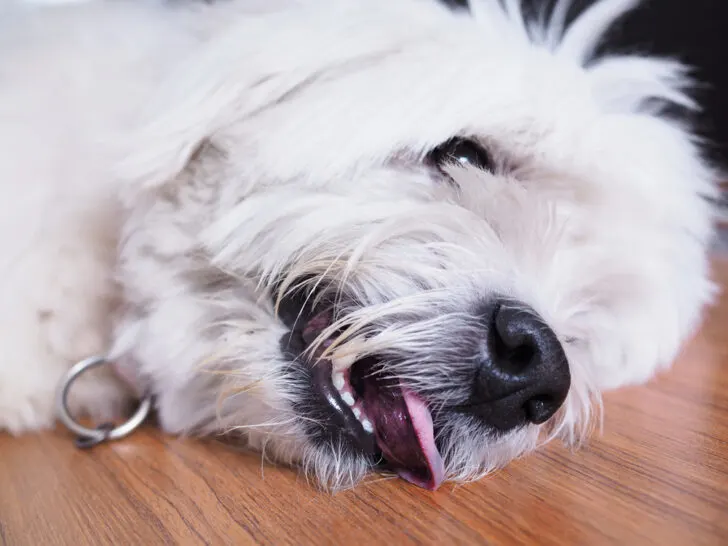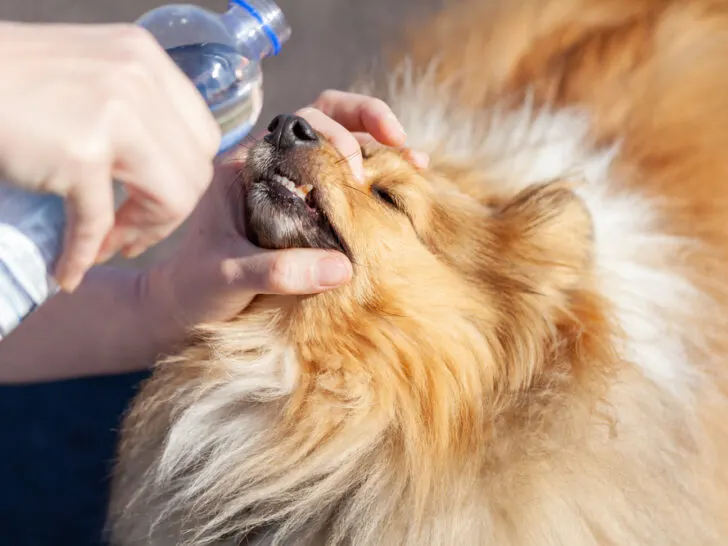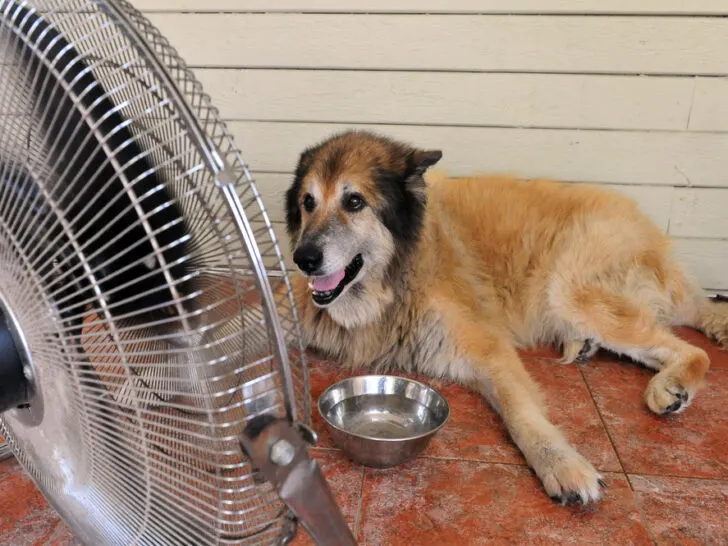Medically Reviewed by Dr. Majid Tanveer, DVM
When the temperature climbs during summertime, we must be aware of heat stroke in our four-legged companions. Taking preventative steps can ensure your pup stays safe and sound, so always pay attention to signs of a possible heat stroke.
As a vet and dedicated pet lover, I understand the importance of staying alert to the signs and symptoms of heat stroke in dogs and taking all necessary prevention steps.
Signs of heat stroke in dogs include rapid panting and heavy breathing, increased heart rate, drooling, weakness or collapse, seizures, bloody diarrhea, and vomiting. Treatment should involve cooling the dog down as quickly as possible with cool (not cold) water and seeking veterinary help.
Shield your pup from heat stroke by offering plenty of shade and fresh water, abstain from intense exercise in the hot weather, and never leave them unattended in a car on scorching days.
Let’s keep our furry friends safe this summer by being mindful of potential heat stroke triggers.
Overview of Heat Stroke

Heat stroke, or hyperthermia, is a condition that occurs when a dog’s body temperature rises above normal (101.5 °F), and the animal is unable to cool itself down.
To regulate their temperature, dogs employ two different methods of cooling off: panting and vasodilation. As they pant, the moisture from their tongues and nasal passages evaporates into the air around them; this allows for an exchange of hot and cool air to occur as it passes over these areas.
When dogs are exposed to sweltering temperatures and humid conditions or partake in vigorous exercise, their bodies can no longer cool down by panting and sweating. As the temperature increases, organs become damaged due to an inability to reduce body heat- ultimately leading to death if left untreated.
Why Does Heatstroke Occur?
Heatstroke typically occurs in hot, humid weather conditions but can also occur without warning at any time of year. Some of the risk factors include:
Breed
Certain breeds of dogs are more prone to heatstroke, such as brachycephalic (short-nosed) breeds like Bulldogs and Pugs. Additionally, these animals are more vulnerable to breathing or heart problems that can worsen their danger of heatstroke.
Age
Puppies and seniors are especially prone to heatstroke due to their reduced tolerance for hot weather. Puppies may have difficulty regulating body temperature, leaving them vulnerable to overheating. Elderly dogs may also have conditions that impede their ability to cool down.
Obesity
Animals with excess weight are more vulnerable to heatstroke since their body’s cooling mechanisms become less effective. Carrying the extra fat puts additional strain on them in hot conditions, making it challenging to maintain a steady temperature.
Over-Exertion
Animals that overexert themselves, whether running or playing too hard, will be more prone to heatstroke.
Physical Fitness
If a pup is unaccustomed to vigorous exercise, his body may not be conditioned for strenuous tasks and heat. This can cause an excessively high internal temperature, leading to dangerous levels of heatstroke if left untreated.
Dehydration
When a dog’s body lacks enough water, it can be at risk of heatstroke as the system is not able to adequately dispose of metabolic warmth. This condition is further aggravated when a dog engages in strenuous activities while dehydrated.
Medical Disorders
Dogs with certain medical conditions, such as heart disease and diabetes, are more prone to heatstroke due to their weakened immune system. In addition, some medications can raise the body’s internal temperature, making the pet even more vulnerable.
Heat Exposure or Trapped in Hot Environments
Dogs exposed to prolonged periods of heat, such as those left in a vehicle or locked in an area without access to cool air, are more likely to suffer from heat stroke. Trapped in these environments, the dog cannot dissipate heat effectively, and the body temperature can rise rapidly.
By recognizing the risk factors associated with heatstroke in dogs, pet owners can take proactive steps to protect their beloved companions from this life-threatening condition.
Signs and Symptoms of Heat Stroke in Dogs

The signs and symptoms of heat stroke vary depending on the severity of the condition but typically include excessive panting, difficulty breathing, increased heart rate, drooling, or salivating excessively.
Rapid Panting
Rapid panting is the most common symptom of heat stroke in dogs. It happens when a dog’s body temperature rises above its normal range, and they have difficulty breathing properly. This painting can be accompanied by other symptoms such as restlessness, drooling, dilated pupils, and bright red gums.
Extremely High Body Temperature
An extremely high body temperature is a tell-tale sign that your dog may have heat stroke. A thermometer can measure this; any reading above 103°F requires immediate medical attention.
Excessive Salivation
Drooling more than usual, accompanied by a lack of appetite and disorientation, are all symptoms to watch out for. Excessive salivation can also indicate your pup is suffering from heat stroke. Additionally, your dog may also vomit or have diarrhea.
Weakness or Lethargy
Behavioral changes such as weakness and lethargy can be seen in dogs with heat stroke. They may become uncoordinated and clumsy, seem confused or disoriented, or even collapse due to the extreme dehydration that comes with heat stroke.
Bright Red Tongue and Gums
A bright red tongue and gums can indicate heat stroke in dogs, indicating that their body temperature has risen too high. This can also cause the dog’s breath to become difficult or shallow.
Vomiting and Diarrhea
If your dog suffers from heat stroke, it may experience vomiting and diarrhea. This can result from their body attempting to cool down by eliminating excess heat through sweating or panting.
Seizures or Uncoordinated Movement
If your dog shows signs of seizures or uncoordinated movements, it could indicate that their body temperature is too high and they suffer heat stroke.
Treatment of Heat Stroke in Dogs

If you assume your pup may be enduring a heat stroke, taking the correct preventive actions at once is essential. With appropriate preventative steps and quick action when needed, you can help ensure your beloved dog stays cool, comfortable, and safe throughout the warmer months:
1. Move your dog to a cooler and shaded area as quickly as possible and provide him with plenty of fresh water.
2. Apply cool (not cold) towels or ice packs to your pup’s chest, neck, head, and groin areas.
3. Provide gentle airflow using fans or air conditioning if you can to help reduce the core body temperature of your pup more quickly.
4. Introduce small amounts of an electrolyte solution formulated for dogs into their mouth every 5-10 minutes until the heat stroke begins to subside and they can swallow on their own again.
5. Monitor his body temperature regularly by taking measurements at least every 10 minutes until it drops to 101°F.
6. In dire scenarios, hospitalization for heat stroke treatment is a must – this will involve oxygen therapy and other supportive care depending on the situation.
7. Follow your vet’s aftercare instructions, including administering medications (if necessary) and taking your pet for regular check-ups to ensure their continued recovery.
8. Finally, taking preventative measures to avoid this condition is essential. This can include providing plenty of shade and water, reducing the outdoor time during hotter months, and allowing your pup to rest regularly.
All these precautions can help ensure your pup stays healthy and safe during the summer!
Prevention of Heat Stroke in Dogs

Preventing heat stroke in dogs is essential for responsible pet owners. Please pay attention to their body language and behavior, and monitor the temperature outside. With the proper precautions, you can minimize exposure to heat and humidity and ensure your pup stays safe.
Be proactive – it could save their life!
1. Keep your pup’s coat trimmed and well-groomed so that there is less fur to absorb heat, especially during summer. Consider choosing a short-haired breed if you live in a hot climate.
2. Limit activity outdoors when temperatures reach 80 degrees Fahrenheit (27 Celsius). Older, overweight, or short-nosed dogs are particularly vulnerable to heat stroke.
3. Try to exercise your pup in the early mornings or evenings when the temperature is cooler. Avoid exercising during midday when temperatures peak and opt for a swim instead!
4. Provide plenty of fresh water whenever you’re out and about – always have a portable water bowl for your pup.
5. Provide shade as a canopy or umbrella when out and about, and ensure adequate ventilation indoors.
6. Never leave your pup alone in the car during hot weather – not even for a few minutes with the windows cracked open! Temperatures can reach dangerous levels quickly in a parked car, even if it doesn’t feel hot outside.
7. Keep an eye on your pup’s behavior – panting excessively or lethargy can be signs of heat stroke. If you notice these symptoms, get them to a cool area and contact your vet immediately for further advice. If you can, bring your pup indoors to avoid extreme weather conditions.
9. Consider investing in cooling products such as a cooling mat or vest that helps keep your pup’s temperature down during the summer months.
10. Make regular visits to your vet for check-ups, especially if your pet has had heat stroke before – they can advise on how to prevent it in the future.
Following these tips should help reduce the risk of heat stroke in dogs, ensuring your pup stays healthy and happy!
Pet Care Tip: Watch this video to learn how to make an intravenous drip for your pup in a medical emergency – from the comfort of your home!
Frequently Asked Questions
Can A Dog Recover From Heat Stroke?
Dogs can recover from heat stroke if the pet owner takes immediate action and adequately manages the situation. Treatment for heat stroke includes cooling the body temperature with cool towels, providing cool water or cold packs to drink, and taking them to a veterinarian for further evaluation.
What Foods Will Hydrate A Dog?
Foods high in water content, such as cucumbers, apples, carrots, and celery, can help hydrate a dog. These foods also provide essential vitamins and minerals to keep your pet healthy. Additionally, providing access to plenty of cool water throughout the day will help ensure your pup stays well-hydrated.
What Can Dogs Drink Besides Water?
Dogs can hydrate with more than just water. Low-sugar electrolyte solutions, such as Pedialyte, replenish essential minerals and electrolytes that may be lost. Diluted milk, fresh fruit or vegetable juice, coconut water, Broths, and other clear soups are also acceptable for dogs – watch out for onions or garlic, which are toxic to them.
How Can I Rehydrate My Dog Fast?
The quickest way to replenish your pup’s fluids is through a drip. Intravenous (IV) fluid therapy delivers liquid, electrolytes, and medications directly into their veins for quick absorption into the bloodstream. This method quickly relieves dehydration without further delay – providing instant relief to your pet!
